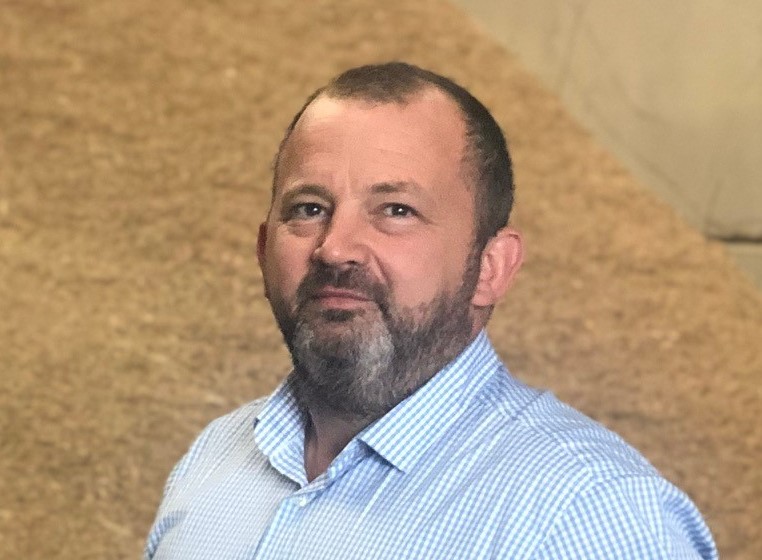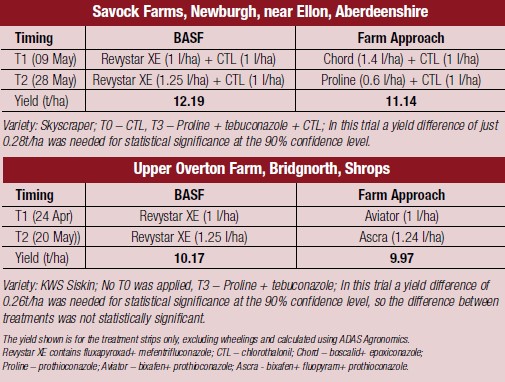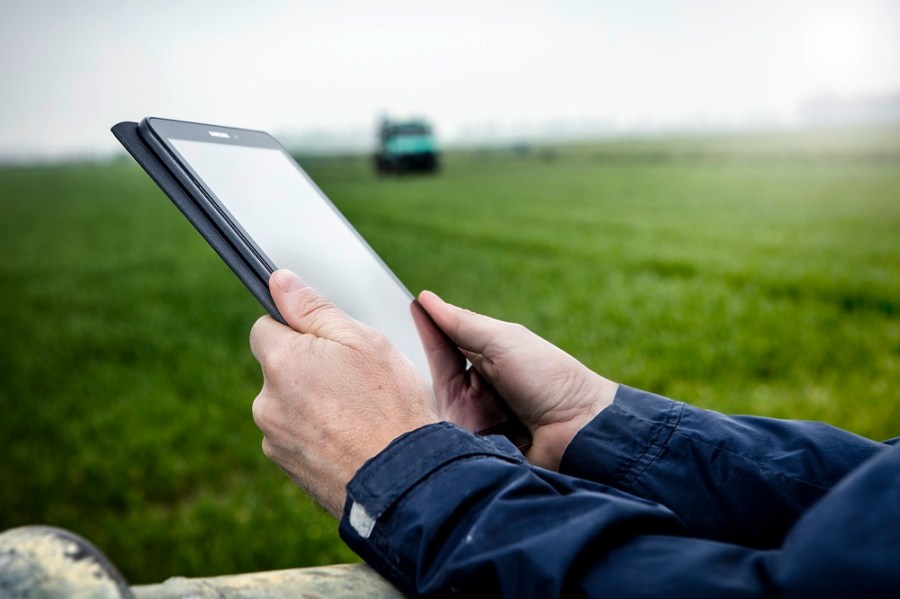There’s already a wealth of information on how best to use Revystar XE, but how do you make sense of it on your own farm? CPM asks two growers with experience of digital platforms and finds out how xarvio Field Manager will fit in.
It’ll become an invaluable way to prioritise and time various treatments when we haven’t got the comfort blanket CTL provides.
By Tom Allen-Stevens
Imagine if you could scan a QR code on a packet of oats which brought up an app that allowed you to trace the product right back to the farm of origin so you could ensure they were gluten-free.
It’s a project involving a number of growers in Aberdeenshire, including Andrew Booth of Savock Farms, near Ellon, who are developing systems to put more trust and integrity into the food industry. It’s built on blockchain, a tamperproof system of digitally filing and preserving a list of records. As well as developing a farmer-owned oat-processing plant, they’ve received almost £100,000 of funding from the Scottish Government Knowledge Transfer and Innovation Fund to pioneer the technology.

Andrew Booth aims to put in place a system that will not only provide reassurance on gluten-free oats, but also digitises the journey.
“If a product’s gluten-free, there are very strict measures everyone, including growers, must follow to avoid contamination,” explains Andrew. “This project puts in place a system that will not only provide that reassurance to the consumer, but also digitises the journey. It’s a much wider project potentially, which could have huge benefits for the whole grain trade.”
Savock Farms extends over 1500ha, with spring and winter oats grown alongside winter wheat, oilseed rape and spring barley, while rye and grass are grown for an AD plant. A keen advocate of digital systems in farming, he’s used various precision farming techniques for more than 15 years. “The most progressive step we’ve taken on this journey is to adopt variable-rate drilling. All crops are sown in this way, including grass,” he says.
Alongside this, he’s been running on-farm trials. “I first started doing them as an AHDB Monitor farmer, and now carry out a number of field trials on the farm for our own benefit as well as for other companies. We’re members of Scottish Agronomy who have a wealth of trials and skills so it’s good to take that small-plot data and turn it into a field trial to gain your own information. I’m also growing crops, such as rye, grass and oats, on which there’s limited trials information.”
Last season was Andrew’s first with BASF’s Real Results. Local BASF agronomy manager Scott Milne suggested he try out Revystar XE against his own standard, based on prothioconazole with one application of boscalid at the T1 timing, with the trial facilitated by Hutchinsons.
“There wasn’t a huge disease pressure last season, but I noticed the crop treated with the BASF programme held on to its flag leaf for a good couple of weeks later than the farm standard plots. I remember raising a concern that they’d never senesce enough for us to put the combine through.
“The difference came at harvest – yields were generally unusually high and our wheats brought in 10.5t/ha on average, which is 1.5-2t/ha above our budget. The Revystar-treated areas yielded comfortably above this, demonstrating a clear benefit from the new chemistry.”
This season, Andrew’s keen to use Revystar in conjunction with xarvio Field Manager, the new digital farming package from BASF (see panel on pxx). “The challenge will be managing the amount of data we now receive across various platforms and making sure it beds in with our current system without overloading the on-farm team,” he says.
“But everything we do is customer-focused. As we get closer to the end user, I want to show that we’re not just blanket-spraying crops, that there’s thought and consideration given to every application. We need tools like xarvio that can provide this reassurance, and I believe it’ll become an essential part of retaining the chemistry we currently have.”
Digital insight
Andrew Williamson is a grower who likes to delve behind the details of any farming progression that comes along. He’s developed a suite of precision farming tools to help manage considerable variability he has over the 320ha he farms on land that undulates between 100-200m above sea level, based at Upper Overton Farm near Bridgnorth, Shrops.
“Farmers fall into two camps when it comes to digital farming,” he says. “There are those who employ a specialist or hire in a service to help them make sense of it, and there are those who take the job on themselves. I’m interested in it and I believe I benefit from the understanding this brings.”
So he’ll bring in weed maps he’s generated from various sources, for example, and create layers within Gatekeeper, his crop recording and mapping software, that will then tie with other layers to produce variable-rate seed plans. “There are packages that can do that for you, but I get to tailor the results how I want them and get to understand the value of the data I have.”
Andrew brings in the same level of analysis when it comes to trying new practices on his crops. A keen advocate of on-farm trials, he’s been involved with BASF’s Real Results since the start and got the first glimpse of Revystar in 2018.
“Unfortunately the trial failed – a crop of JB Diego that was the worst on the farm and died off early in the drought. So last year, I was determined to get a true picture of how the new chemistry performs,” he says.
This time it was a crop of KWS Siskin, with Revystar applied over three tramlines to give three replicates, with the results assessed and calculated using ADAS Agronomics. But Andrew’s been doing his own monitoring through the season, too. “I went to Ireland to see the Revystar trials at Teagasc and noticed the visual difference, so when I came home, I set about assessing my own. You could see the difference between the treatments – the Revystar areas had more green leaf area.”
One aspect in particular he’s focused on is the use of CTL – this was deliberately omitted from both the comparison treatments, although it was used elsewhere on the farm. “There was a clear yield benefit from Revystar over the farm standard, but I got a yield lift from using CTL elsewhere, although this comparison didn’t go through the rigorous ADAS Agronomics to give me confidence in the results,” notes Andrew.
“Revystar is a step forward and will clearly help, but we’re going to be left exposed when we can’t use CTL, especially here in the West where septoria pressure is higher. We mustn’t become too reliant on the new chemistry and develop other means to relieve disease pressure.”
Andrew’s looking forward to using xarvio Field Manager in the coming season to help with this. “It’s a decision management tool that’ll help me make the right choices based on live local data it’ll bring in. I can see it’ll become an invaluable way to prioritise and time various treatments when we haven’t got the comfort blanket CTL provides.
“But I hope I’ll be able to delve beneath the surface, too, and bring in other data that will help inform those decisions with xarvio. Like anything, you’ll get as much out of a system as you put into it. That’s especially true of data and in my experience many farmers are too precious about hanging on to their data, to their own detriment.”
2019 Real Results trials

What is Field Manager?
Field Manager from xarvio is a web and smartphone app-based crop production optimisation system, designed to help you make the right decision on when and how to treat your crops (currently wheat, barley and oilseed rape).
Due to go on commercial release in 2020, it’s been trialled across Europe, including 14 on-farm development sites in the UK, and is the second of a suite of new tools, following the launch of smartphone-based xarvio Scouting last year.
“There are a couple of new functions we’ve released on Scouting,” notes Louis Wells, UK solutions and services manager at BASF. “Multiweed Detection allows you to take an image of a patch of weeds and xarvio will pick them out and identify what they are. Emergence Analysis counts how many crop plants/m² you have. Currently it works just with sugar beet and maize, but the plan is to widen its scope to include oilseed rape and cereals. These build on the five existing tools that help you assess crop status, weed, pest and disease pressure simply through uploading images through the app.
“But Field Manager will be the big launch in 2020. We’re really excited about how this will help growers make decisions on managing their crops, and particularly keen to see how it can support the use of Revystar XE,” he says.

Spray Timer advises on if, and when to spray, factoring in what field management tasks you’ve already performed.
There are three modules in Field Manager:
- Field Monitor pulls satellite imagery into your dashboard during the season to give you an idea of biomass cover, and also leaf area index, based on normalized difference vegetation index (NDVI). The information is useful for in-season monitoring, such as to tell whether variable applications of seed and/or fertiliser have evened up a crop, and to relate biomass scans to yield maps.
- Spray Timer is a field-specific service that takes in information you enter about variety, drilling date, etc, and puts it through a clever algorithm that brings in local weather data and crop-growth information to advise on if, and when to spray to protect your crop most efficiently. The neat bit is that it factors in what field management tasks you’ve already performed. A traffic-light system indicates when you need to get the sprayer out, and special symbols help you prioritise jobs. The tool factors in what you’ve already used, with drop-down menus containing a comprehensive line-up of products, including generics and competing brands to the BASF products.
- Zone Spray makes use of the biomass maps and gives you a variable-rate application map, allowing you to adjust fungicide and/or growth regulator based on crop cover. Like Spray Timer, the module builds in information on previous applications and current disease pressure to determine rate. Safeguards within the module ensure statutory label rates and concentrations are not compromised, but with the variable application based on the fungicide input, the performance of tank-mix partners is at the user’s risk. A variable rate application tank-mix including a herbicide product for example is not recommended.
“Feedback we’ve had suggests Field Manager predicts growth stage very accurately with the Spray Timer module offering decision support on a range of key cereal diseases. The tool interacts at the field level giving advice on your local situation. It even considers the protection and curativity given by your fungicide inputs. The more users who come on board, the better it will get as the algorithms learn as they go along,” notes Louis.
While xarvio Field Manager is an independent platform, which is powered by BASF, Revystar is set to work neatly within the system, he says. It’s the first major product launch from BASF since the development of the xarvio suite of services. The wealth of trials data BASF holds on Revystar will be incorporated to help optimise user decisions within Field Manager. “We know Revystar has a relatively long application window, for example, with plenty of data to back this up. Field Manager takes this into account and the algorithms will update automatically as new information is made available.
The team has also made progress in ensuring Field Manager ties in seamlessly with other platforms, says Louis. “Compatibility is a key priority for us, and we’re aware it’s also a key requirement for farmers. We have a new interface with MyJohnDeere that works wirelessly with Field Manager, and we’re connected to Agrirouter, bringing compatibility with the large number of services also using the platform. Our vision is that xarvio should work seamlessly and with minimum effort, whatever systems you’re running or level of service you require,” he notes.
- xarvio Scouting is available free to download for iOS and Android smartphones. Field Manager will be launched later this year – pricing information has not yet been released.
Digital Direction
As arable farms progress towards a digital future, it can be difficult to know which forms of data generation, capture and analysis provide a really worthwhile benefit to the business, and which are costly and time-wasting distractions. CPM is working with some of the industry’s leading companies in this area to bring growers some Digital Direction. These articles track the significant steps on the journey towards the data-enabled farm, and also explain and profile the technologies involved.
CPM would like to thank BASF for sponsoring this Digital Direction article and for providing privileged access to staff and material used to help bring it together.
xarvio Digital Farming Solutions, is at the forefront of the digital transformation of agriculture. xarvio delivers independent field-zone-specific agronomic advice enabling farmers to produce crops in the most efficient and sustainable way. Optimize your crop production, contribute to sustainable agriculture. Plan Smarter. Grow Better.




